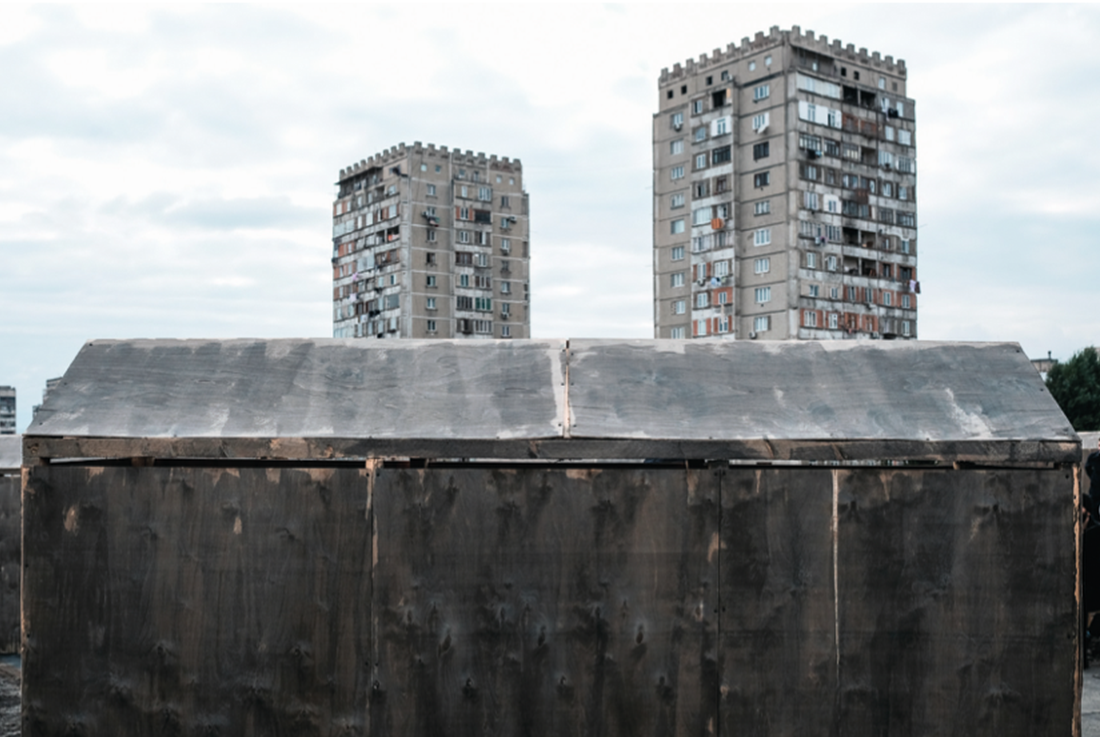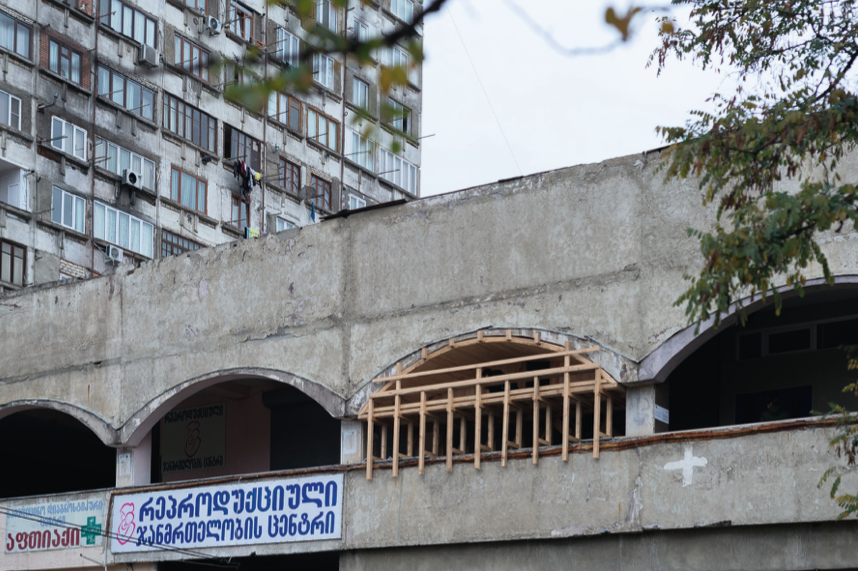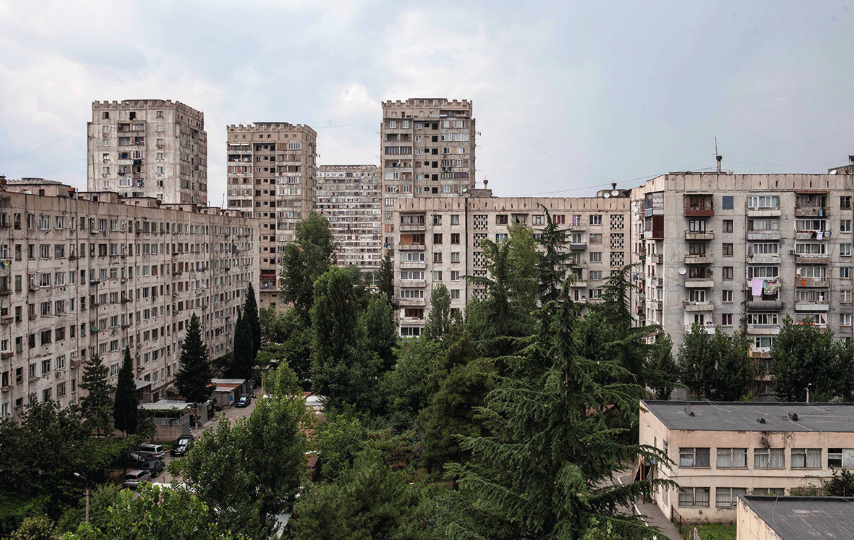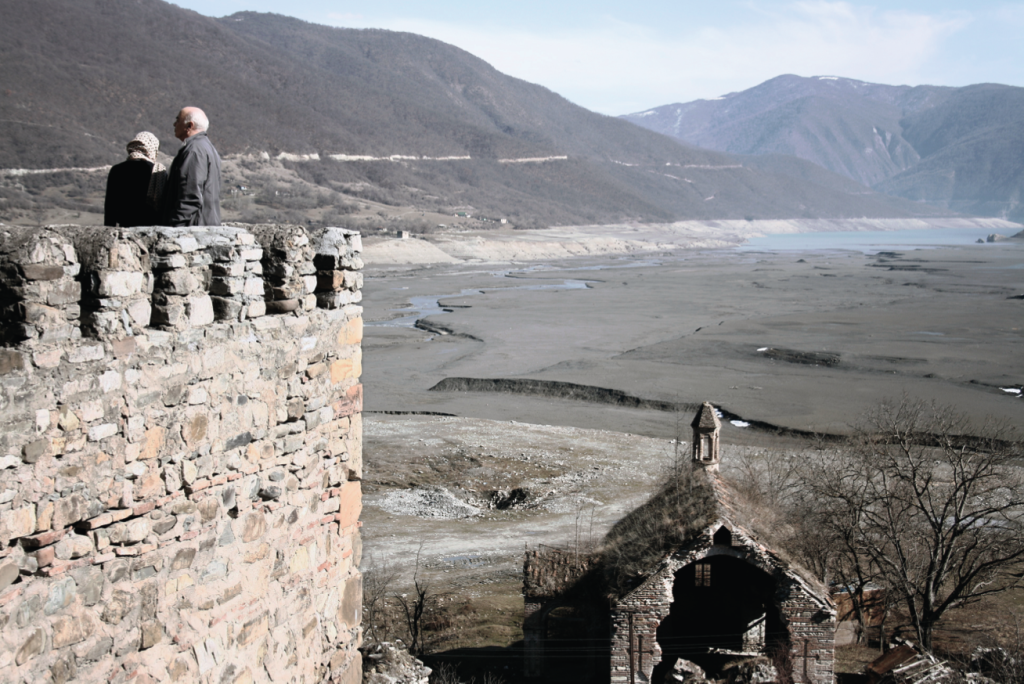Interview with Tinatin Gurgenidze, co-founder of the Tbilisi Architecture Biennial.
Tinatin Gurgenidze studied architecture and urban design in Tbilisi and Barcelona. Trained as an architect and urban designer, Tinatin is involved in research and curatorial work regarding critical urban issues. She is one of the co-founders of the Tbilisi Architecture Biennial. Her work concentrates on a sociological approach towards architecture and urban space. In her work she tries to understand what happened to Gldani in the transition period after Georgia regained its independence in 1991.

Tbilisi Architecture Biennial was based in the suburb of Gldani. Photo: © Sandro Sulaberidze
Explain me more about the Tbilisi archi- tectural biennial?
Ever since I left Georgia, I always wanted to do something there. I started my PhD research about a neighbourhood in Tbilisi, and at some point in 2017 spent half a year in Georgia. This is when the idea of making a cultural event like this came up. With some friends we made this utopian idea of es- tablishing an architectural biennial in 2017. Afterwards we managed to organise the first edition in 2018. The main reason was the lack of cultural activities in Georgia concern- ing architecture and also a lack of critical discourse. It was important to create a plat- form to bring different actors together and talk about certain topics. The second im- portant reason was to engage with the city critically and talk about existing problems.
Do you also involve different communi- ties in this discourse?
The initial idea was to create it for the local audience, but as we had less expertise, and we lacked experience of creating such events, we made it quite international at the beginning. The local audience was not so much present at first, probably because it was the first time and they didn’t really un- derstand what we were doing, but it grew dramatically in the last two editions. Our audience is very diverse because we make very interdisciplinary activities. For example, in the last edition we had the film screenings where a completely different audience at- tended compared to the symposium. Each activity has different audiences, and it’s always open to new people depending on what is happening. In terms of participation it’s quite international, but oriented towards and based on local topics.
What did LINA offer the biennial?
This was probably the most important things for us, as being part of the LINA platform gave us so many connections throughout Europe with different organisations, and also a lot of support. Without LINA we would not have gone so far. I feel very grateful for that, and I think we sometimes forget how important it is to come together and share things, which is what LINA does. We’ve also got partners for another project that we met through LINA.
What’s it like to create such events in a precarious situation of work, as a freelancer?
I’m not completely a freelancer, because I work for a local NGO in Berlin which partners with the biennial, and my colleagues in Georgia also have part-time employment as well. Creative Europe funding allows us to have salaries, which is a very positive thing. There’s so much energy and time that we’ve invested for free, overworking, but slowly with experience and the results it all gets rewarded.

Tbilisi Architecture Biennial was based in the suburb of Gldani. Photo: © Tako Robakidze

Your PhD thesis is based on the (post-) Soviet mass housing settlement of Gldani, a suburb of Tbilisi. Can you tell us more about that?
It’s a complicated story. When I started my PhD I did my research and then stopped it because of lack of time, as I was involved in the organising the biennial. I have a plan to start again this year. It changed a lot from what I was researching and what I want to research now, because I am work- ing on the period of transformation after the break-up of the Soviet Union and introduc- tion of the market economy, and how this influenced the built environment. I would like to research the typologies of the self-made structures and this transformation that hap- pened in this period and archive the cases. I know the typologies will disappear, but I would like to pay attention to this phenom- enon because this is also the period when self-made architecture was done, and it’s also an architectural style that needs to be studied. Some people doesn’t consider the self-made as an architectural style, so I have to prove why it’s important to document this.
How did the neoliberal period influence the architecture and society in Georgia?
To an extreme extend. From one radical system we shifted to another radical system. This had – and is having – a massive influ- ence, especially in exploiting the resources like selling valleys and forests to foreign investors. The feeling of common owner- ship is completely lost. This process has gone so far that for the last few years there have been movements and protests against it, and this means there’s some hope. Still, the situation is so extreme that people are also losing their homes in a very brutal way. The banking system is rather violent in its actions, and this has a drastic influence on people’s lives. The discourse is now open- ing more and more around the topic of com- mon resources, and that forests shouldn’t be sold to one owner. People are slowly starting to understand this, and the related protests started from the rural areas, not in the big cities, which is a strength. But it’s also very important that the protests have reached the centre, and that more and more people understand the problem here.
What about the privatisation of water in Georgia?
We worked on this topic during the Venice Biennial last year and we will continue to talk about it this year during the Tbilisi Bi- ennial. Water in Georgia is one of the most valuable resources, as the country has so many different bodies of water – from natural springs to lakes, rivers, glaciers and the sea. The reality is that not everybody has equal access to the drinking water. Some have made water into a commodity and make money from it, while on the other hand the local people, those who live near it, might not have access to drinking water in their homes. It is a paradox how this can hap- pen and a form of modern colonisation that affects the environment and ecosystems, because it’s not really controlled. There is a problem of what kind of contracts are being made and how the natural resources are be- ing sold. It should not be possible to sell an entire valley or a river to a private investor, this is something that has to belong to the country and its people.

How do you see architecture in the future?
A lot of rethinking must be done about what architecture is and what it can be in the fu- ture. We must really think if we need to build completely new buildings and urbanise so much territory. We must start to radi- cally change things, and not to build new so many new structures. It’s been proven many times that reconstruction is much more eco- friendly and cheaper. How much more can we build? According to the calculations, with more people coming into the cities, we will need to build more, but how far can we go? If we build more, more people will come, and therefore we need to find a bal- ance among the land, rural areas and cities, which can’t grow endlessly. Architecture is not a profession that stands alone – it’s con- nected to everything around it.

Exploring the Relationship Between Time and Energy: The Georgian Pavilion at the 2023 Venice Biennale is curated by the Tbilisi Architecture Biennial. Photo: © Gigi Shukakidze

Exploring the Relationship Between Time and Energy: The Georgian Pavilion at the 2023 Venice Biennale is curated by the Tbilisi Architecture Biennial. Photo: © Tobias Schmitt
Written by:
Boštjan Tadel
Text: Boštjan Bugarič
Photographs: Tako Robakidze, Sandro Sulaberidze, Gigi Shukakidze, Tobias Schmitt







